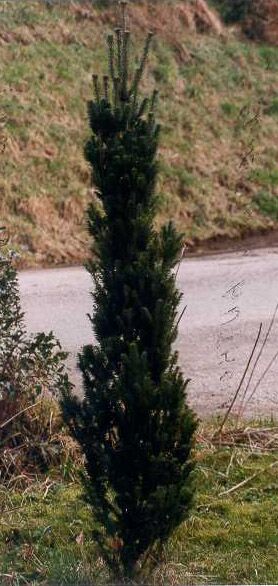Abies alba 'Fastigiata' is one of the most narrow, columnar cultivars of the European silver fir; thus, only slightly resembling it. The needles are shorter and denser than those of the species, measuring only 0.4 to 0.88 inch (10 - 22 mm) long, often curved upward. After 10 years of growth, a mature specimen will measure 8 feet (2.5 m) tall and 28 inches (70 cm) wide, an annual growth rate of 10 inches (25 cm).
This cultivar is consider rare, and may not exist in North America. Fastigiate, like Lombardy poplar (Populus nigra 'Italica'). Needles short, narrow, evenly whorled around the twigs.
This cultivar originated as a random natural mutant, found in the early 1800s by the botanist Reynier of Avignon in the forests of the Grande Chartreuse, France. Introduced to the nursery trade in 1846 by Seneclauze Nursery, France, but remaining on of the rarer columnar cultivars.
In the nineteenth century, the names 'Fastigiata', 'Pyramidalis' and 'Stricta' had been applied to two cultivars. The confusion was apparently caused by Carriere's different treatments in 1855 and 1867 and/or misreporting of his 1855 work in 1867, although it was agreed that one of the two cultivars also occasionally turned up in seed beds. Seneclauze (1867) was clear there were two: 'Fastigiata Stricta' with radially arranged needles (the plant he introduced in 1846) and 'Fastigiata Metensis' with pectinate needles. Lawson cited 'Pyramidalis' in 185` without a description. Carriere in 1855 cited 'Fastigiata' and 'Pyramidalis': 'Fastigiata' was the 'Pyramidalis' of Seneclauze, and had pectinate or subpectinate needles and branches more spreading and thicker than Carriere's "Pyramidalis', the leaf arrangement which he did not describe, but said was 'Metensis' of Seneclauze Cat. (an obscure work of c.1854). 'Stricta' was lost, according to Welsh (1993) and if that is the case we would recommend dropping the name 'Stricta'. (RHS Encyclopedia of Conifers, 2012.)
